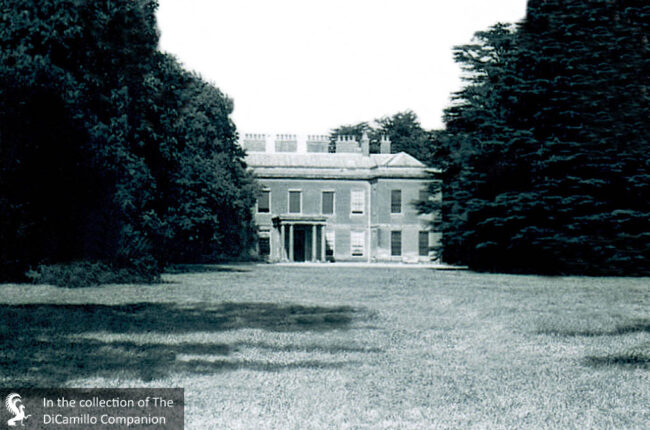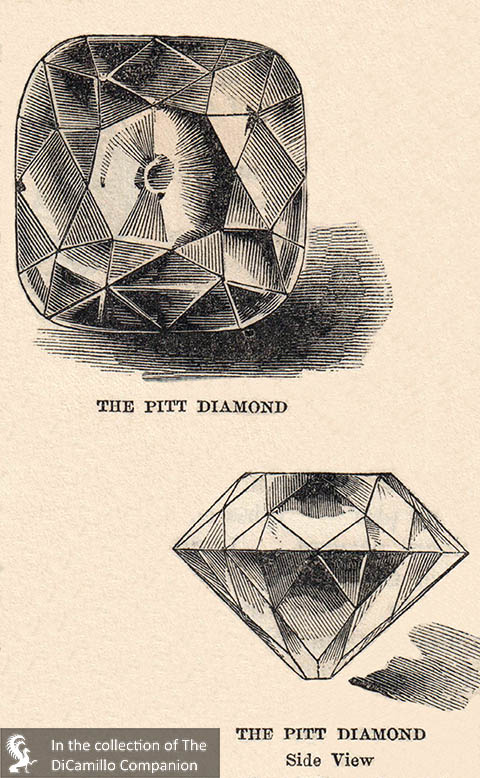
The house from a circa 1907 postcard

The Pitt Diamond from an 1866 issue of "Harper's New Monthly Magazine." The diamond, today called Le Regent, is in the collection of the Louvre.
Earlier Houses: There were two earlier houses on, or near, the site of the current house: the 13th century house of the Despencer family, which was replaced by the Tudor house of the Backhouse family.
Built / Designed For: 2nd Earl of Clarendon
House & Family History: In the late 17th century Henry Hyde, 2nd Earl of Clarendon, engaged William Talman to build a new H-shaped house for his wife, the Swallowfield heiress Flower Backhouse, daughter of William Backhouse, the famous alchemist and inventor. The monumental doorway re-erected in the garden was originally the northern entrance to Talman's house; its finely carved garlands and drapery are among with the best work of the period. Internally, little of Talman's house remains, for, in 1825, Sir Henry Russell altered virtually all the interiors. In addition, Sir Henry had the house's red brick façade plastered and added a small portico. Sadly, the installation of a new staircase for Sir Henry necessitated the removal of a richly carved cornice made for the 2nd Earl of Clarendon by Grinling Gibbons. Thomas "Diamond" Pitt, who owned Swallowfield for approximately 10 years in the early 18th century, was a member of Parliament and the grandfather of Prime Minister William Pitt (Pitt the Elder, later 1st Earl of Chatham). Diamond Pitt is famous, or infamous, today as the English merchant who served as president of Madras, and who, in 1701, purchased a 410-carat uncut diamond from an Indian merchant (the stone was reputed to have been stolen from Abul Hasan Qutb Shah). Pitt paid the enormous sum of £20,400 (approximately £45 million in 2019 values using the labour value commodity index) for the stone, which he then sent to England hidden inside his son Robert’s shoe. After its arrival in Britain Pitt engaged London jewelers, between 1704 and 1706, to cut the diamond into smaller, saleable pieces. The most famous stone to emerge was the Pitt Diamond, today Le Regent, a 141-carat cushion brilliant diamond (a number of the secondary stones were sold to Peter the Great). In 1717 Pitt sold the 141-carat stone to the French regent, Philippe II, Duke of Orleans, for £135,000. As such, it was part of the crown jewels of France until the French Revolution in 1789. Le Regent, aka the Pitt Diamond (see “Images” section), has been on view at the Louvre since 1887. With the enormous proceeds he received from the sale of the stone, Diamond Pitt went on a country house spending spree, buying many estates, particularly in the West Country. Swallowfield, in Berkshire, was the exception; it was supposedly Diamond Pitt's favorite home and it was here that he died in 1726.
Garden & Outbuildings: John Evelyn, the late 17th century diarist, visited the gardens and planted the yew walk. Afterward, he wrote that they were "as elegant as 'tis possible to make a flat by art and industry and no mean expense." He was delighted by "the delicious and rarest fruits [and the] innumerable timber trees in the ground about the seat," the walks and groves of elms, limes, oaks and other trees, the quarters, walks and parterres, the nurseries, the kitchen garden, two noble orangeries and "above all, the canal and fishponds, the one fed with white, the other with a black running water" stocked with pike, carp, bream and trench. The little five-arched bridge over the Blackwater, as well as the walled garden, were built for Thomas "Diamond" Pitt, who purchased Swallowfield from the 3rd Earl of Clarendon circa 1717. Not far away is a pet cemetery, wherein is the grave of Bumble, Charles Dickens's dog.
Architect: John James
Date: Circa 1720-22Architect: William Atkinson
Date: 1824-26John Bernard (J.B.) Burke, published under the title of A Visitation of the Seats and Arms of the Noblemen and Gentlemen of Great Britain and Ireland, among other titles: Vol. I, p. 219, 1852.
Title: Biographical Dictionary of British Architects, 1600-1840, A - SOFTBACK
Author: Colvin, Howard
Year Published: 1995
Reference: pgs. 86, 539, 952
Publisher: New Haven: Yale University Press
ISBN: 0300072074
Book Type: Softback
House Listed: Grade II*
Park Listed: Grade II
Past Seat / Home of: SEATED AT EARLIER HOUSES: Sir John Despencer, 13th century. William Backhouse, until 1662; Backhouse. SEATED AT CURRENT HOUSE: Henry Hyde, 2nd Earl of Clarendon, 1690-1709; Edward Hyde, 3rd Earl of Clarendon, 1709-17. Thomas "Diamond" Pitt, 1717-26. Sir Henry Russell, 1st Bt., 19th century.
Current Ownership Type: Flat Owners Company / Condo Association
Primary Current Ownership Use: Flats / Multi Family
Ownership Details: Upon the financial collapse of the Country Houses Assocation, Swallowfield was sold and converted into flats in 2004.
House Open to Public: No
Historic Houses Member: No